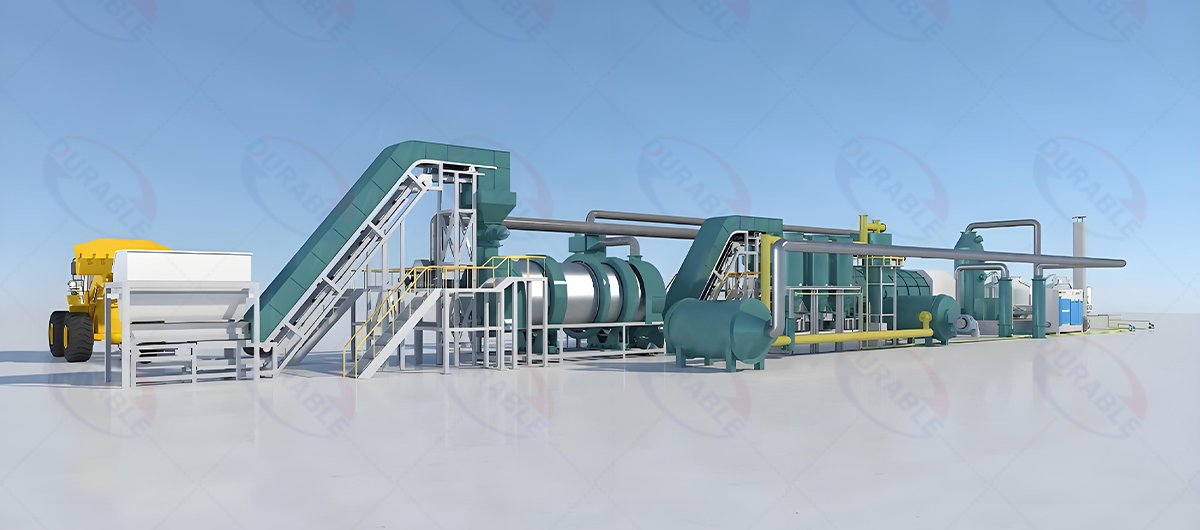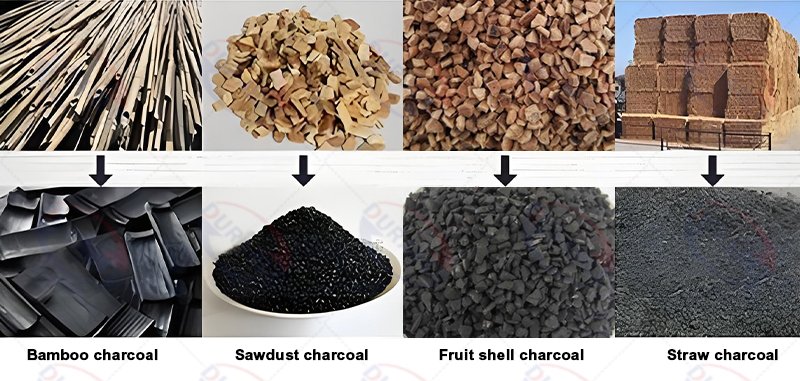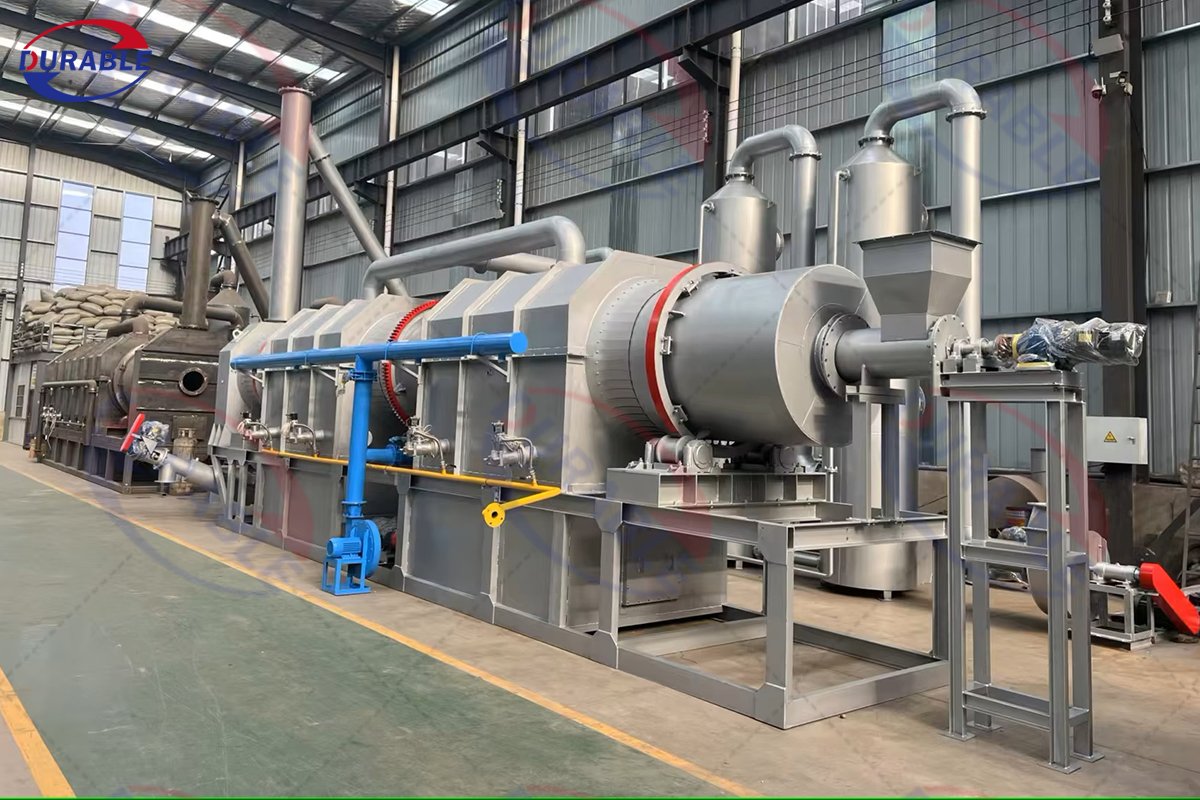Double Layer Drum Carbonizer | 4th Gen High-Efficiency
The carbonization furnace, also known as carbonization kiln, continuous carbonization kiln, is composed of four major parts: feeder, carbonization furnace, flue gas purification system and cooling machine.
Heating Materials:
Charcoal, Wood, Diesel, Natural Gas, LPG, Biomass, etc.
Application Materials:
1. All kinds of biomass waste, such as sawdust, Coconut shells, olive shells, palm shells, bamboo, etc. 2. Civil sludge, municipal sludge, industrial sludge, etc 3. MSW.
Table of Contents
- What Are the Advantages of the 4th Gen Double-Layer Design Compared to Older Models?
- How Can I Improve Raw Material Carbonization Rate and Final Product Quality?
- What Types of Biomass Raw Materials Can the Equipment Handle?
- What Are the Equipment’s Operating Costs (Energy, Labor, Maintenance)?
- Can the Flue Gas and Tar Treatment System Meet Environmental Standards?
- How Do I Calculate the Equipment’s Return on Investment (ROI)?
- How Do I Choose the Right Equipment Model and Configuration Based on Production Needs?
- What Technical Support and After-Sales Service Should a Manufacturer Provide?
- FAQs
What Are the Advantages of the 4th Gen Double-Layer Design Compared to Older Models?
The biggest advantage is not the double-layer itself, but the incredibly precise control it gives you over the process. Almost every manufacturer talks about the double-layer design. The inner layer dries the material, and the outer layer carbonizes it, using recycled heat. This is not new technology. The true “fourth-generation” leap is in how the furnace handles the combustible gas (syngas) it creates. It’s all about fine-tuning the internal energy loop.
A top-tier fourth-generation double-layer carbonization furnace gives you precise command over this process. It controls the oxygen supply for burning the syngas. It also manages the gas recirculation path and its combustion temperature. This is not just for creating “free” heat. It is a tool for actively shaping the environment inside the carbonization drum. By managing the syngas fire, you decide if the carbonization is happening in an “oxygen-poor” or a completely “oxygen-free” atmosphere. This control directly shapes the pore structure and fixed carbon content of your final product. This is what determines whether your charcoal is good for a weekend barbecue or valuable enough for the industrial activated carbon market. Don’t just ask about thermal efficiency. Ask about the control system’s brain. Is it a sophisticated PID controller or just a simple on/off switch? This is the detail that defines the quality of your product and the profitability of your business.

How Can I Improve Raw Material Carbonization Rate and Final Product Quality?
You improve quality by creating and sticking to a “process recipe” and having a skilled operator. The key to a high carbonization rate and excellent quality is consistency. You cannot achieve consistency by just pushing a button. The secret is to treat the process like a chef preparing a fine meal. You need the right recipe and a skilled cook. The recipe includes the exact settings for feed rate, temperature, and drum rotation speed.
A skilled operator is your cook. He or she will learn to listen to the sounds of the machine. They will observe the color of the flame from the syngas burner. They will check the color and texture of the finished charcoal. Based on these observations, they will make small adjustments to the “process recipe” to account for slight changes in the raw material. Relying purely on automation is a trap for newcomers. No sensor can perfectly account for the natural variations in biomass. A good operator, assisted by a good automation system, is the key to maximizing both your output and your product quality. This combination ensures your continuous drum carbonization furnace runs at its peak potential every single day.
| Factor for Quality | Why It Matters | Your Practical Action |
|---|---|---|
| Stable Temperature | Prevents under-cooked (brown) or over-cooked (ashy) product. | Invest in a furnace with PID control, not simple on/off systems. |
| Consistent Feedstock | Uniform size and moisture lead to uniform carbonization. | Invest in good pre-treatment (drying and crushing) equipment. |
| Skilled Operator | Can make fine adjustments that automation cannot. | Invest in training your staff. A good operator pays for themselves. |
What Types of Biomass Raw Materials Can the Equipment Handle?
In theory, it can handle many types. In practice, you must optimize the furnace for one specific type of material at a time. Sales brochures will show you a long list of compatible materials: wood chips, sawdust, rice husks, coconut shells, and even sludge. While the machine can physically process them, each material behaves very differently when heated. Each one has its own ideal carbonization curve, which is a specific profile of temperature and time.
If you run your furnace with the settings for wood chips but feed it with rice husks, you will get a poor-quality product. There is a more serious problem. The ash from different materials has different chemical properties. For example, rice husk ash is full of silica. At a certain temperature, this silica can melt and form a hard, glass-like slag on the inside wall of the drum. This slag is a disaster. It ruins heat transfer, causes extreme wear, and can only be removed by shutting down the furnace and using heavy tools. The best strategy is to focus on one or two materials with similar properties. If you must switch between different materials, you must develop, test, and save a unique “process recipe” for each one. Switching recipes is a critical step that cannot be skipped.


What Are the Equipment’s Operating Costs (Energy, Labor, Maintenance)?
The real operating costs go far beyond the furnace itself. Your biggest expenses are often raw material drying and ongoing maintenance. When calculating costs, you must look at the entire industrial charcoal production line. The furnace is just one part.
- Energy Costs: The biggest energy user is not the furnace, but the dryer. The furnace uses its own syngas for heat, but you must first dry your raw material. Taking biomass from 50% moisture down to 15% requires a lot of energy. This pre-treatment step is often the largest part of your monthly utility bill.
- Labor Costs: While the system is automated, it is not “unattended.” You need at least one skilled operator per shift. This person is vital for ensuring quality and preventing problems. Trying to save money with cheap labor is a mistake that will cost you more in the long run through lost production and equipment damage.
- Maintenance Costs: This is the hidden cost that can destroy your profits. The seals at the inlet and outlet of the rotating drum are critical wear parts. Cheap graphite seals fail quickly in the hot, dusty environment. A failed seal leaks air in, which can cause a fire, or leaks flammable gas out, which is a safety hazard. We strongly recommend investing in systems with superior sealing technology, like gas seals or mechanical seals. The veteran I spoke with called these cheap seals “profit-eating devils” for a reason.
Can the Flue Gas and Tar Treatment System Meet Environmental Standards?
A well-designed and well-maintained system can meet strict standards. But “tar management” is more honest than “tar elimination.” Any biomass pyrolysis equipment will produce tar. The fourth-generation system is designed to handle this effectively. It is a multi-stage process. First, the combustible syngas, which contains a lot of tar vapor, is burned as fuel. This destroys much of the tar. Then, the remaining exhaust gas goes through a cyclone dust collector to remove solid particles. After that, it usually enters a spray tower or wet scrubber, which uses water to cool the gas and wash out remaining pollutants.
However, the veteran warned me about a hidden problem. Even with this system, tar can slowly build up in pipes, valves, and burners, especially during startup or shutdown. This buildup can reduce efficiency and, if ignored, lead to a full blockage. A good system is designed for easy maintenance, with cleaning ports in key locations. To meet environmental standards consistently, you cannot just buy a good machine. You must also commit to a strict schedule of inspection and cleaning for the entire gas treatment line. This is a core part of running an eco-friendly charcoal machine legally and responsibly.
How Do I Calculate the Equipment’s Return on Investment (ROI)?
To calculate a realistic ROI, you must include the cost of the entire system, not just the furnace. A common mistake is to underestimate the initial investment and overestimate the production. A true calculation is straightforward but requires honest numbers.
Step 1: Calculate Your Total Initial Investment (Capital Cost)
- Cost of the carbonization furnace itself.
- Cost of the pre-dryer.
- Cost of the crusher or chipper.
- Cost of the cooling conveyor and any briquetting machines like a charcoal briquette machine.
- Cost of shipping, installation, and operator training.
- Cost of the factory building and foundation.
Step 2: Calculate Your Monthly Operating Costs
- Cost of raw materials (including transportation).
- Cost of electricity and water.
- Cost of labor (your skilled operators).
- Cost of maintenance (spare parts like seals, lubricants).
Step 3: Calculate Your Monthly Revenue
- Your selling price per ton of charcoal.
- Multiply by your realistic monthly production tonnage. (Be conservative at first).
How Do I Choose the Right Equipment Model and Configuration Based on Production Needs?
The right model depends on three things: your material, your target market, and your production scale. Choosing a furnace is not like buying a car. You cannot just pick one from a catalog. It should be a consultation process with the manufacturer.
- Your Raw Material: As we discussed, different materials require different handling. If you are processing something corrosive or abrasive, you may need a drum made from special stainless steel (like 310S) instead of standard boiler plate. We at Durable will ask about your material first.
- Your Target Market: Are you selling charcoal for barbecue or for industrial use? If you are aiming for the high-value industrial market, you will need a furnace with the advanced PID controls we talked about to guarantee high fixed carbon content. If you are selling lump charcoal for restaurants, you might need a slower carbonization process to get larger, unbroken pieces.
- Your Production Scale: This seems obvious, but it is not just about tons per hour. You need to match the capacity of the furnace with the capacity of your dryer, crusher, and briquetting machines. A bottleneck anywhere in the line means the entire system is inefficient. We help our clients design a balanced line where every component works together smoothly.
Technical Parameters
| Model | THL0812-IIII | THL1016-IIII | THL1218-IIII | THL1420-IIII | THL1622-IIII |
| Outer drum | 1220*7500 | 1620*7500 | 1824*7500 | 2024*7500 | 2224*7500 |
| Inner Drum | 820*9500 | 1020*9500 | 1224*9500 | 1424*9500 | 1624*9500 |
| Rotary drum | 5.5kw | 5.5kw | 5.5kw | 7.5kw | 18.5kw |
| Feeding conveyor | 4+3kw | 4+3kw | 4+3kw | 4+3kw | 5.5+7.5kw |
| Air blower | 3+4kw | 3+4kw | 3+4kw | 3+4kw | 3+4kw |
| Main fan | 11kw | 15kw | 30kw | 30kw | 37kw |
| Cooling conveyor | 5.5kw | 5.5kw | 5.5kw | 5.5kw | 5.5kw |
| Calcining compartment 1 | 2600*3500 | 2600*3500 | 2600*3500 | 2600*3500 | 2600*3500 |
| Calcining compartment 2 | 1240*6000 | 1640*6000 | 1840*6000 | 2040*6000 | 2040*6000 |
| Insulation container | 6000*1860 | 6000*2240 | 6000*2440 | 6000*2640 | 6000*2640 |
| Condensor | 1900 | 1900 | 1900 | 1900 | 1900 |
| Heating ignition burners | Electric Ignition 7 units( PLC Control) | ||||
What Technical Support and After-Sales Service Should a Manufacturer Provide?
The relationship should not end after the machine is delivered. Essential after-sales support is what separates a supplier from a true partner. Buying a piece of heavy equipment like this is the beginning of a long-term relationship. The manufacturer’s support is critical to your success. Here is what you should demand:
- System Design Consultation: They should help you design the entire production line, not just sell you a furnace.
- Installation and Commissioning: They should offer to send their engineers to your site to supervise the installation and get the machine running correctly.
- Operator Training: This is crucial. The manufacturer should provide thorough training for your operators on how to run the machine, perform daily maintenance, and spot early signs of trouble.
- Process Optimization Support: They should help you develop the initial “process recipes” for your specific raw materials.
- Readily Available Spare Parts: When you need a new seal or sensor, you cannot afford to wait weeks for it to be shipped. A good manufacturer keeps a stock of critical spare parts.
At Durable, we provide all of these services. We know that we only succeed if you succeed. We are committed to being your partner for the entire life of the equipment.
FAQs
Q1: Is a “smokeless” carbonization furnace truly smokeless?
A: It is more accurate to call it “self-sustaining.” It captures the flammable smoke (syngas) and burns it as fuel. When operated correctly, the final exhaust is mostly steam and CO2 and meets environmental laws. However, smoke can be produced during incorrect startup or if the system is poorly maintained.
Q2: How much charcoal will I get from one ton of biomass?
A: The yield, or conversion rate, is typically between 25% and 30% for dry biomass. This means one ton (1000 kg) of biomass with about 15% moisture will produce 250 to 300 kg of charcoal. The exact yield depends on the material type and the process parameters.
Q3: What is the best moisture content for the raw material?
A: For the best efficiency and quality, the raw material should be dried to under 15% moisture before it enters the carbonization furnace. Any higher, and the furnace will waste a lot of energy just boiling off water, which lowers your production rate.
Q4:How long does the furnace take to heat up?
A: Heating up an industrial-scale furnace from a cold start can take several hours (typically 3-5 hours). This is why they are designed for continuous operation. It is much more efficient to run the machine 24/7 than to start and stop it every day.
Q5: Can I use this machine to make biochar for agriculture?
A: Yes. By adjusting the carbonization temperature and time, you can produce biochar with the specific properties needed for agricultural use. Generally, a lower carbonization temperature (around 400-500°C) is used to create biochar that is good at retaining water and nutrients in the soil.
 Durable Machinery
Durable Machinery
